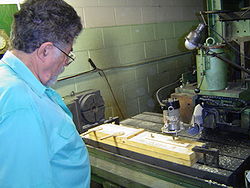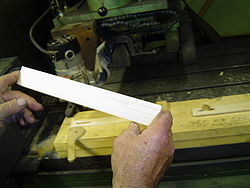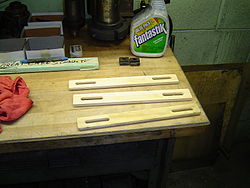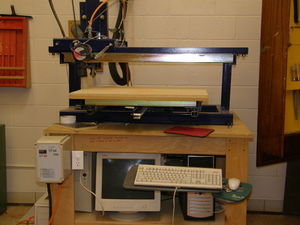CNC wood router
This article needs additional citations for verification. Please help improve this article by adding citations to reliable sources. Unsourced material may be challenged and removed. (May 2009) |
A CNC wood router uses CNC (computer numerical control) and is similar to a metal CNC mill with the following differences:
- The wood router typically spins faster — with a range of 13,000 to 24,000 RPM
- Low end hobby grade machines typically uses smaller tools — typical shank size 20 mm or at most 25 mm. Professional quality machines frequently use surface facing tools up to 3" in diameter or more, and spindle power exceeding 15 horsepower. Machines capable of routing heavy material at many hundreds of inches per minute are common.
- Some machines use smaller toolholders MK2 (Morse taper #2 - on older machines), ISO-30, HSK-63 or the tools just get held in a collet tool holder affixed directly to the spindle nose. ISO-30 and HSK-63 are rapid-change toolholding systems. HSK-63 has begun to supplant the ISO-30 as the rapid change standard in recent years.
A wood router is controlled in the same way as a metal mill, but there is a lot of CAM and CAD software like Artcam, Mastercam, Bobcad, and Featurecam specifically for wood routers.
Wood with different grain must be approached with unique strategies, and wood CAM software is less likely to need to have hog-out strategies than the metal ones. Wood routers are frequently used to machine other soft materials such as plastics at high speed.
Typical three-axis CNC wood routers are generally much bigger than their metal shop counterparts. 5' x 5', 4' x 8', and 5' x 10' are typical bed sizes for wood routers. But can be built to accommodate very large sizes up to, but not limited to 12' x 100'. Most table routers use a three motor drive system (xyz) utilizing either servo or stepper motors that drive the router motor via a gantry system. The gantry system isolates the XYZ movement in the top part of the machine with a stationary table holding the workpiece. Many CNC metal mills have the cutter motor moving on the Z axis, and a table which moves in X and Y for added stability.
Many wood routers can run at machining speeds of 25 metres/min (linear) or faster with a few machines such as the Anderson capable of 40 metres/min, Onsrud capable of 86 metres/min.
Contents
[hide]Features
Separate heads
Some wood routers have multiple separate heads that can come down simultaneously or not. This design is generally not as easy as a toolchanger with ISO-30 or HSK-63, though it is easier to maintain. Some routers have multiple heads that can run complete separate programs on separate table all while being controlled by the same interface.
Dust collection
The wood router typically has 6"-10" air ducts to suck up the wood chips/dust created. They can be piped to a stand-alone or full shop dust collection system.
Some wood routers are specialized for cabinetry and have many drills that can be programmed to come down separately or together. The drills are generally spaced 32 mm apart on centres - a spacing system called 32 mm System. This is for the proper spacing of shelving for cabinets. Drilling can be vertical or horizontal (in the Y or X axis from either side/end of the workpiece) which allows a panel to be drilled on all four edges as well as the top surface. Many of these machines with large drilling arrays are derived from CNC point-to-point borers.
Securing the workpiece
Suction systems
The wood router typically holds wood with suction through the table or pods that raise the work above the table. This type of hold-down is used for components which require edge profiling (or undercutting), are manufactured from solid wood or where greater flexibility in production is required. This type of bed requires less extraction with greater absolute vacuum.
A second type hold down requires a "spoil board" or "cull sheets" to the work. This allows vacuum suction through the low density table and allows the placement of parts anywhere on the table. These types of tables are typically used for nest-based manufacture (NBM) where multiple components are routed from a single sheet. This type of manufacturing precludes edge drilling or undercut edge work on components. However most industrial sized machines similar to the S series CNC by Vortech Routers or C.R. Onsrud Panel Pro allows the use of spoil boards or a pod system that elevates the work piece to accommodate edge work.
Vacuum pumps are required with both types of tables where volume and "strength" are determined based on the types of materials being cut.



